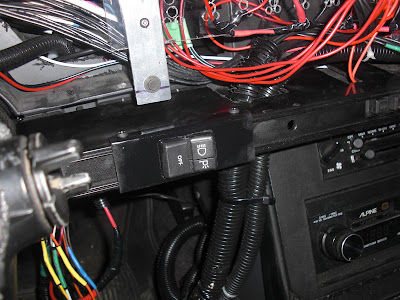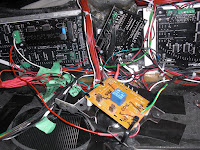I have worked out a wiring scheme (above) for the mini Adafruit 2MB Sound FX Board for supplying power to the board, wiring up the momentary buttons that activate the sound FX on the board and the audio out jack.
 The power supply is simple, I'm basically using the same 12V to 5V step-down converter (right) or transformer model that I used for my GPS screen, I solder the 5V output wires onto the Adafruit board. I may introduce an on/off switch into the wiring scheme to have further control over if the board is powered or not. If I do I'll probably do that on the 12V input side of the step-down converter module. A simple switch to Relay should work well for that.
The power supply is simple, I'm basically using the same 12V to 5V step-down converter (right) or transformer model that I used for my GPS screen, I solder the 5V output wires onto the Adafruit board. I may introduce an on/off switch into the wiring scheme to have further control over if the board is powered or not. If I do I'll probably do that on the 12V input side of the step-down converter module. A simple switch to Relay should work well for that.
The momentary buttons to activate the various sound FX on the Adafruit board I will hook up to both my Lower Console's Space Matt buttons and my Switch Pod buttons. So far on the sound FX board I have:
- Knight Rider Theme (Narrated)
- Knight Rider Theme (Un-Narrated)
- File Open Sound FX
- File Close Sound FX
- Scanner Sound (Loop)
- Radar Sound (Loop)
- Turboboost
- K.I.T.T. Introduction
- Surveillance Mode FX
I have a little room to add more if I like but I think for anything more complex I will get the 16MB version of the same board in order to use more sound if I find I need more. But for now these should do for simple things.
The Knight Rider themes I have set on the board to play in next order so when you press the button the first theme plays and at the end of the theme when you press the button again the other version of the them plays.
The File Open sound FX I have sent to just play when the button is pressed, my thought is that I will have those sounds play when I turn on the LCD Screen or GPS Screen.
File Close sound FX will play when I turn off either monitor.
Scanner sound FX loop I have set as a "Latching" function on the Adafruit board, the sound plays until the button is pressed again, so looping sounds are best for the boards "Latching" function.
Same set up for the Radar and Surveillance sound FX loops.
Turboboost FX is set as just a single play on button press same as K.I.T.T.s introduction. I could very easily add other introductions and have those play in a random order as the Adafruit sound FX board has a very nice feature for playing random sound files too, but for now I'm just using the classic K.I.T.T. introduction ;)
Here is a little additional work done on the diagram to include a power on off switch and to use the option of either a Relay or Optocoupler as switch option for the momentary button to activate the board sounds.
 As you can see I have mounted the Scanner control box to the underside of the cover plate I am still working on. Once I get the dash completely settled as to where it will sit properly and I have drilled in holes to screw the side wings onto the stock OEM dash then I can work on completing the underside cover plate more which is going to involve a little work with making a temporary cardboard form so I can fabricate the fibreglass to fit. But anyways, that's a whole different ball game, for now I'm happy that we have our Scanner control box location all sorted out.
As you can see I have mounted the Scanner control box to the underside of the cover plate I am still working on. Once I get the dash completely settled as to where it will sit properly and I have drilled in holes to screw the side wings onto the stock OEM dash then I can work on completing the underside cover plate more which is going to involve a little work with making a temporary cardboard form so I can fabricate the fibreglass to fit. But anyways, that's a whole different ball game, for now I'm happy that we have our Scanner control box location all sorted out.

































